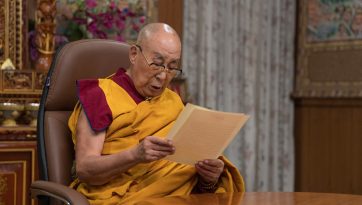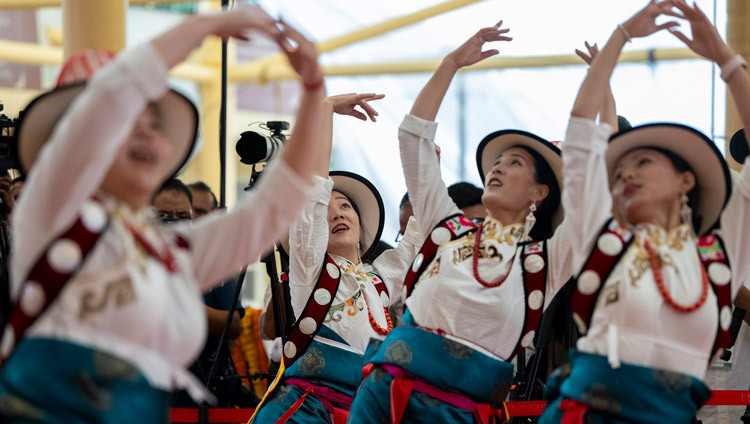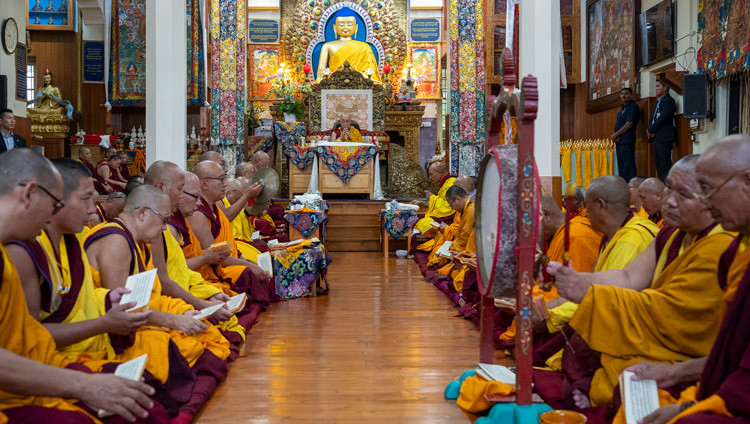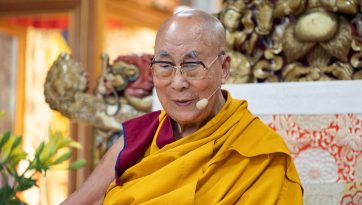Essence of True Eloquence – Second Day
October 3, 2020
Thekchen Chöling, Dharamsala, HP, India – When His Holiness the Dalai Lama arrived this morning, he saluted the two groups in the virtual audience, monks at Yunlin and monastics and laypeople in Taipei. They waved to him as he took his seat.
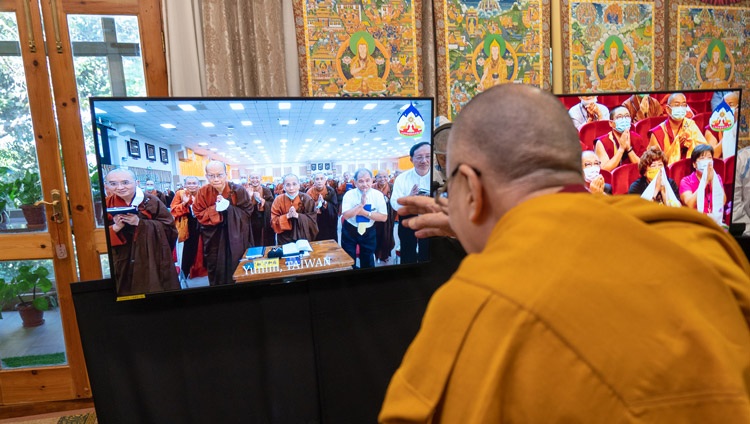
“Today is the second of these teachings,” he began. “We don’t need to use reason to prove that we want to be happy, not to experience suffering. The root of suffering is our self-cherishing attitude and our misconception of the true existence of people and things. This is reflected in the verse you say at the end of your recitation of the ‘Heart Sutra’.
May we dispel the three poisons (anger, attachment and ignorance),
May the light of wisdom shine forth.
May we overcome all obstacles
And enter into the practices of a bodhisattva.
“These poisons or mental afflictions are rooted in ignorance, which will not be eliminated by saying prayers or reciting mantras, but by meditating on selflessness, that is, developing wisdom. The final line refers to cultivating bodhichitta and engaging in the practices of bodhisattvas.
“The reason we’re listening to this discourse today is so our wisdom may shine forth. However, there is a saying that if, after diligent study, you have not been able to integrate what you learned within you, it won’t have served the purpose. Trulshik Rinpoché, who came to Lhasa specially to receive teachings on the ‘Stages of the Path’, used to tease me about the great knowledge of Geshés that bore no fruit.
“Jé Tsongkhapa says in his ‘Destiny Fulfilled’,
In the beginning, I sought much learning.
In the middle, all teachings dawned on me as spiritual instructions.
In the end, I practised night and day.
I dedicated all this virtue for the dharma to flourish.
Thinking this over now, how well my destiny was fulfilled!
Thank you very much, Noble Lord Wisdom Treasure!
“We should follow in his footsteps. As the ‘Ornament for Clear Realization’ states, Shravakas and Pratyekabuddhas are led to their goal of liberation through understanding the basis. Bodhisattvas are able to fulfil their goal to help others through knowledge of the path. Buddhas are able to give a variety of teachings according to the disposition of the disciples. The purpose of the three vehicles (the Shravaka, Pratyekabuddha and Bodhisattva yanas) is to overcome our destructive emotions and gain control of our minds. To dispel the darkness of ignorance within us, we must study and practise. As Jé Rinpoché said, he practised night and day.
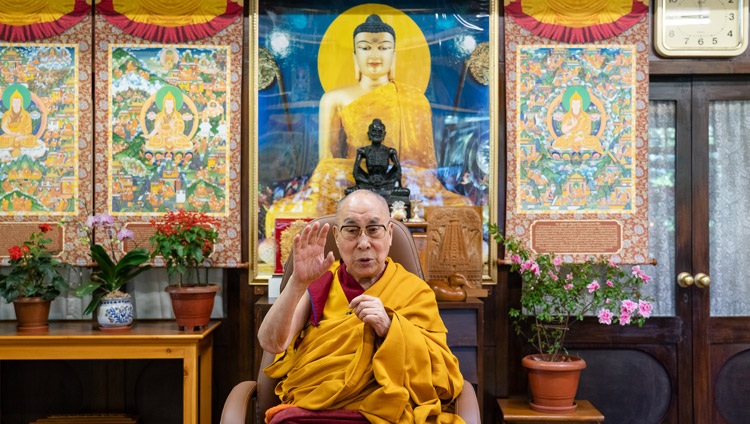
“I advise Tibetans to become 21st century Buddhists and I advise you to do the same, which means developing a sound understanding of the teachings. You need to use your intelligence to discern right from wrong and examine how spiritual practice can be of benefit today.
“As I mentioned yesterday, when I was small, I memorized ‘Entering into the Middle Way’ and ‘Ornament for Clear Realization’. I studied ‘Collected Topics’ logic and reason on the basis of Purba Chok’s text book. To begin with it didn’t interest me very much, but later I realized that what I had learned was useful.
“Just as Jé Rinpoché dedicated his merit as Manjushri and Samantabhadra have done, the followers of the Sakya Lam Dré tradition and the Kagyus who follow the ‘Jewel Ornament of Liberation’ make prayers for the spread of the dharma for the good of sentient beings.”
His Holiness resumed reading the ‘Essence of True Eloquence’. He noted that at the beginning Jé Rinpoché writes that the teaching is based on reason. The texts of Dignaga and Dharmakirti on logic are very important and His Holiness again encouraged his listeners to translate those and Purba Chok’s ‘Collected Topics’ into Chinese.
“The text states that the Buddha gave some teachings that are regarded as provisional and others that are definitive. Those that deal with ultimate reality are definitive, others, which can’t be taken literally, are provisional.
“The point here is that in his first round of teachings, the Buddha taught as if things have self characteristics. But, on Vulture’s Peak, in the second round, the perfection of wisdom teachings, he taught that everything from form to the omniscient mind is devoid of an intrinsic identity. Because these instructions were not comprehensible to some disciples, in the third round of teachings at Vaishali he explained the three natures — imputed, dependent and perfect nature.
“The ‘Unravelling of Thought Sutra’ speaks of the non-duality of subject and object, which quantum physics touches on too. Form, sound and so forth appear to have their own objective existence, but do not actually exist that way. Deeper investigation reveals that they’re merely designated by name and do not exist as they appear. External objects and subjective mind are said to be of the same nature.
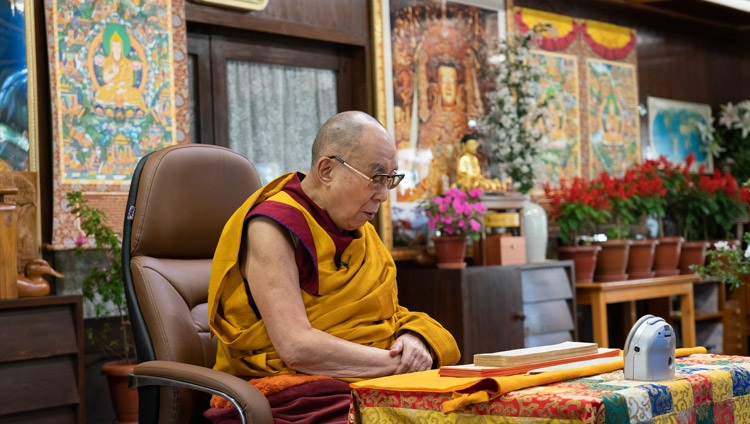
“When we feel attachment to something beautiful, or aversion to something ugly, the Mind Only instruction that such things are just of the nature of the mind reduces our attachment or aversion.”
His Holiness moved on to the section dealing with the Middle Way view. He noted that the interpretation of the Middle Way relies on Chandrakirti’s ‘Clear Words’ and Bhavaviveka’s ‘Blaze of Reasoning’. There is mention of the four reliances: reliance on the teaching and not the teacher, reliance on the meaning and not the words, reliance on the definitive meaning and not the interpretable meaning, and reliance on wisdom and not on (ordinary) consciousness.
Nagarjuna’s ‘Fundamental Wisdom’ opens with praise of the Buddha for teaching dependent arising free from the eight extremes:
I prostrate to the perfect Buddha,
The best of all teachers, who taught that
That which is dependent origination is
Without cessation, without arising;
Without annihilation, without permanence;
Without coming; without going;
Without distinction, without identity
And peaceful – free from fabrications.
And the treatise ends with an appreciation of the way the Buddha gave teachings to rid us of all distorted views:
I prostrate to Gautama
Who, through compassion,
Taught the exalted Dharma,
Which leads to the relinquishing of all views.
From the point of view of the nature of things, there is no arising and no cessation. In terms of the object, there is no coming and no going. In terms of continuity, there is no annihilation and no permanence, and in terms of designation, things are neither one nor different. Things arise and cease, but if you analyse them, trying to find arising or cessation within an object, they can’t be found.
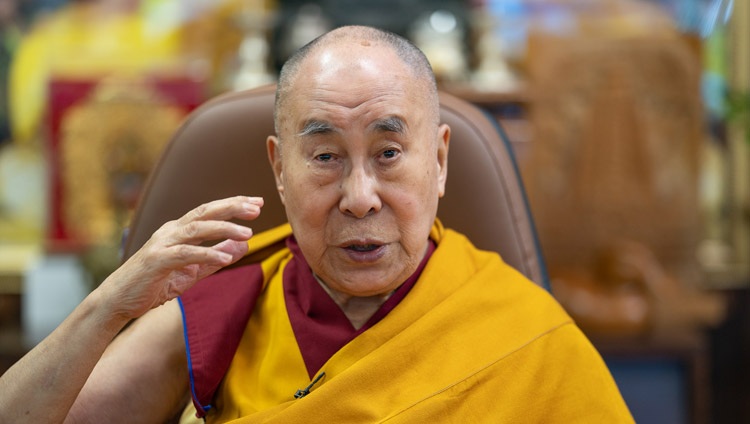
“When the mind is absorbed in the reality of things, their diversity disappears,” His Holiness observed. “I am not my body, my speech or my mind. These three are not me. If we search for body, speech, mind or the ‘I’ within the psycho-physical aggregates, we won’t find them.
“Non-Buddhist traditions speak of an entity besides our body, speech and mind, which they label ‘atman’. As a concept it’s useful for understanding past and future lives. The Autonomous Middle Way School (Svatantrika Madhyamaka) points to the mental consciousness as the identity of a person that goes from life to life. However, the Consequentialists (Prasangikas) say nothing can be found when we search for it. Nothing can be found as a separate entity. Nothing has any essence in and of itself or from its own side.
“Things have no essential core in and of themselves. In his ‘Entering into the Middle Way’, Chandrakirti explains that things having objective existence would entail four logical fallacies: that the Arya being’s meditative absorption on emptiness would be the destroyer of phenomena; that it would be wrong to teach that things lack ultimate existence; that the conventional existence of things would be able to withstand ultimate analysis into the nature of things, and that it would be untenable to state that things are empty in and of themselves. As Nagarjuna puts it:
That which is dependently arisen
Is explained to be emptiness.
That, being a dependent designation,
Is itself the middle way.
“Dependent arising has the power to dispel both extreme views simultaneously. When we understand things are dependently arisen, we understand that they are empty of any intrinsic existence. When we understand that things are devoid of intrinsic existence, this brings about an understanding of dependence.“
His Holiness announced he would stop there for the day and answer questions from the audience. Discussing the way the mind misapprehends a self independent of the psycho-physical aggregates he cited the first verse of Chapter 22 of Nagarjuna’s ‘Fundamental Wisdom’.
Neither the aggregates, nor different from the aggregates,
The aggregates are not (dependent) on him, nor is he (dependent) on the aggregates.
The Tathagata does not possess the aggregates.
What else is the Tathagata?
He mentioned that he often reworks this to refer to himself and reflects on it accordingly:
I am neither one with the aggregates, nor different from the aggregates,
The aggregates are not (dependent) on me, nor am I (dependent) on the aggregates.
I don’t possess the aggregates.
What else am I?
He told another questioner that as yet modern science has not paid a great deal of attention to the workings of the mind and emotions, although the value of peace of mind is beginning to be acknowledged. However, scientists are interested in the concept of dependent arising.
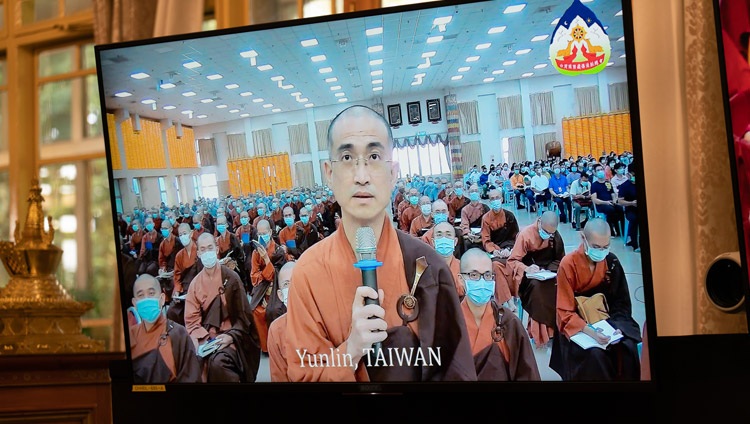
He pointed out that dreams are often used as an analogy for something that doesn’t exist.
Clarifying the term dependent arising, he suggested that dependence shows that things are not independent, while arising shows that things arise through dependence. An understanding of dependent arising leads to understanding of emptiness and that things are relative. Choné Lama Rinpoché said that dependence does not deny emptiness, and arising means things conform to worldly convention. Dependent arising is an authentic teaching of the Buddha.
“I’ve been meditating on emptiness for sixty years and on bodhichitta for fifty,” His Holiness divulged. “Over that time my understanding has grown. When I reported my experience of emptiness to Yongzin Ling Rinpoché, he was pleased and told me, ‘Before long you’ll be a space-yogi.”
He mentioned that because sentient beings have Buddha nature, they have the potential to attain Buddhahood. Enlightenment is possible because the mental afflictions are adventitious and can be eliminated. Once the three visions cease, no mental afflictions arise and there manifests an experience of clear light.
His Holiness was asked how to reduce anger and attachment in the short term. He replied that when we understand that anger, attachment and ignorance arise on the basis of exaggerated attitudes that are rooted in a sense that things exist independently, we’ll be able to reduce them. He observed that destructive emotions are cunning and we must not only cultivate an understanding of emptiness, but, equally important, habituate ourselves to the idea. He noted that one of the connotations of the Sanskrit and Tibetan terms for meditation is to gain familiarity.
He commented that the idea of emptiness is relatively new to us, whereas we have been familiar with clinging to the notion of independent existence since time without beginning. We can thank the Buddha, Nagarjuna and Chandrakirti for opening our eyes.
SOURCE:https://www.dalailama.com/news/2020/essence-of-true-eloquence-second-day





